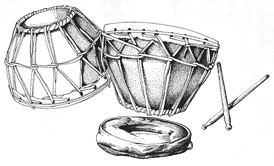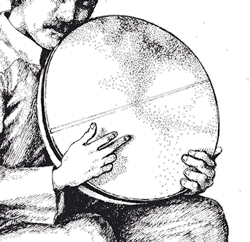|
Commissioning drum-making
Talking one day about how we both wanted to own authentic
Sufi drums, we decided to go out on the town and commission to our
specifications frame drums and small kettledrums traditional for Mevlevi
rituals. We visited a drum shop on Yüksek Kaldırım street at the top
of the funicular railway, near the Mevlevi lodge in the Galata
district of Beyoğlu. For his frame drum, Aka picked out a sheep skin
prepared for a drum head; I picked out a goat skin. We must have also picked
out smaller sheep skins for the small kettledrums. 
Right: Kudüm kettledrum set drawing of the very
instruments described in the text, illustrating two
views of the drums, a cushion, and drumsticks. Click for larger image.
Next stop was Bak ırcılar
Sokağı
(Copper Craftsmen Street) just outside
the Kapalı Çarşı,
or Bedestan
(Covered
Bazaar) in the old part of Istanbul. Aka gave our specifications to a
craftsman to beat a sheet of copper into the classic kudüm shape and (I
forget the details of this next step) at some point described the
traditional skin lacing to the person applying the heads, the fashioning of
the wooden drum sticks, and the two doughnut-shaped cushions for each
kettledrum to rest on. This kettledrum design resembled drums we
saw in museums, rather than the timpani-like drums of, say, Istanbul Radio,
which had key-operated screws for tuning.

Nearby the Copper Craftsmen Street, we stopped by the
Kalburcular
Sokağı (Sieve-makers Street). The frame of the frame drum is the same shape and
materials of a traditional Turkish flour sifter, but covered with a skin
instead of a screen (left) (Click for larger image). Aka gave the order for the frame drum size and depth to
a sieve-maker, who varnished the outside of the wood and covered the skin
edge with a black velvet band. I had my frame drum completed with a cat-gut
string on the outside, the cat-gut kindly supplied by a Turkish surgeon
friend in Istanbul.
home | Konya
last revised 21 September 2008
|